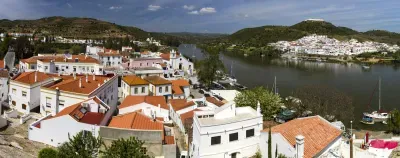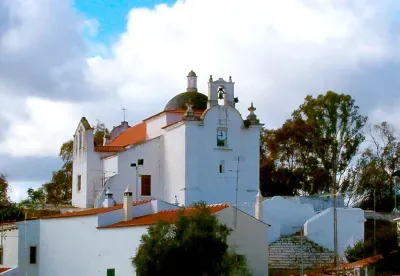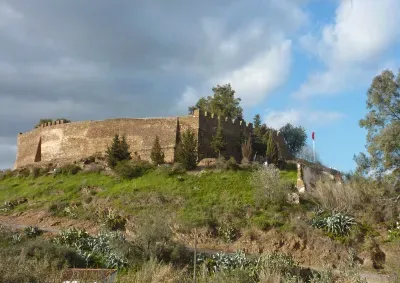
Situated around 40km (25 miles) from the coast, on the banks of the river Guadiana is the attractive village of Alcoutim. The village lies more or less on the northern border of the Algarve with the Alentejo, and more importantly the river border with Spain.
There is the feeling that little has changed in Alcoutim for hundreds of years. The steep cobbled streets all seem to lead to the riverside through a jumble of low, whitewashed cottages and little squares. The paved esplanade is a great spot to relax in one of several cafes whilst watching the fishing boats landing their catch or yachts moored at the little marina.

Close to the riverfront is the main church, the Igreja Matriz do Salvador de Alcoutim . Dating back to the 16th century this is one of the earliest examples of Renaissance architecture on the Algarve. Above the door of the church can be seen the coat of arms of the Marquises of Vila Real and Counts of Alcoutim.
Perhaps the grandest structure in the village is the Hermitage of Nossa Senhora da Conceição. Built to incorporate the ruins of a 16th century Manueline church this mostly 18th century overlooks the village with its cupola clearly visible from far around
Given Alcoutim's strategic position it is perhaps unsurprising that the village is overlooked by a 14th century castle. The views from the ramparts here are perhaps the best in Alcoutim taking in the village below and the river as it winds its way in both directions. There is a small charge for admission to the castle but this includes access to the little archeological museum that is housed within.

Along with the castle, the hilltops here bear reminders of far older defensive structures. These reflect the village's historic importance as a river port which goes back as far as the Bronze Age. Originally it was the ores of minerals such as iron, copper and manganese which were mined and smelted before being shipped down the river to the Mediterranean and beyond. This continued through a series of occupations; first the Romans followed by the Visigoths and then the Moors. The area was eventually reconquered in 1240 by King Sancho II.
One reason Alcoutim grew and thrived in this particular location is due to the geography of the river for it is at this point that the river Guadiana becomes tidal. This meant ships would often have to wait here for hours on end before continuing their journey up or down stream.
On the other side of the river is a the Spanish village of Sanlucar, a near carbon-copy of Alcoutim with its own castle surrounded by a cluster of whitewashed cottages. Back in the 14th century these neighbouring villages were enemies during the Portugal / Castile wars. It was here, on a boat in the middle of the river that in 1371 Kings Henrique of Portugal and Fernando I of Spain signed a peace treaty.
Today, boats regularly shuttle back and forth between the two villages.

Whilst swimming in the river is not advised on account of the strong currents Alcoutim does in fact have its own beach. On a small tributary of the river Guadiana (the Ribeira de Cadavais) is a charming little river beach, the Praia Fluvial do Pego Fundo. This safe and sandy beach has plenty of facilities including summer lifeguards and is even classified as accessible.